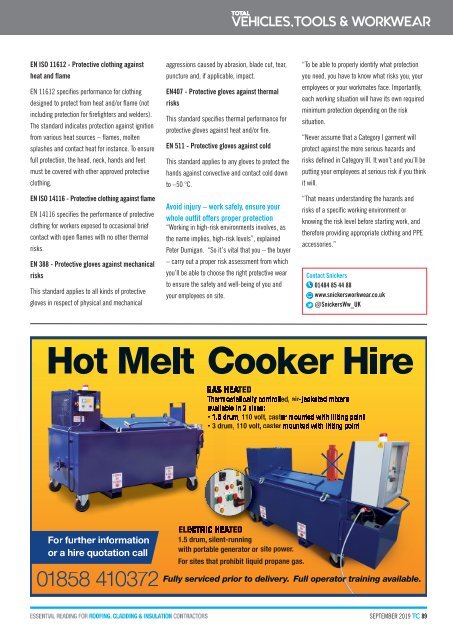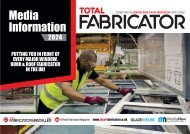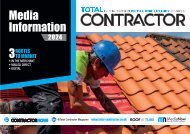September 2019
You also want an ePaper? Increase the reach of your titles
YUMPU automatically turns print PDFs into web optimized ePapers that Google loves.
EN ISO 11612 - Protective clothing against<br />
heat and flame<br />
EN 11612 specifies performance for clothing<br />
designed to protect from heat and/or flame (not<br />
including protection for firefighters and welders).<br />
The standard indicates protection against ignition<br />
from various heat sources – flames, molten<br />
splashes and contact heat for instance. To ensure<br />
full protection, the head, neck, hands and feet<br />
must be covered with other approved protective<br />
clothing.<br />
EN ISO 14116 - Protective clothing against flame<br />
EN 14116 specifies the performance of protective<br />
clothing for workers exposed to occasional brief<br />
contact with open flames with no other thermal<br />
risks.<br />
EN 388 - Protective gloves against mechanical<br />
risks<br />
This standard applies to all kinds of protective<br />
gloves in respect of physical and mechanical<br />
aggressions caused by abrasion, blade cut, tear,<br />
puncture and, if applicable, impact.<br />
EN407 - Protective gloves against thermal<br />
risks<br />
This standard specifies thermal performance for<br />
protective gloves against heat and/or fire.<br />
EN 511 - Protective gloves against cold<br />
This standard applies to any gloves to protect the<br />
hands against convective and contact cold down<br />
to –50 °C.<br />
Avoid injury – work safely, ensure your<br />
whole outfit offers proper protection<br />
“Working in high-risk environments involves, as<br />
the name implies, high-risk levels”, explained<br />
Peter Dumigan. “So it’s vital that you – the buyer<br />
– carry out a proper risk assessment from which<br />
you’ll be able to choose the right protective wear<br />
to ensure the safety and well-being of you and<br />
your employees on site.<br />
“To be able to properly identify what protection<br />
you need, you have to know what risks you, your<br />
employees or your workmates face. Importantly,<br />
each working situation will have its own required<br />
minimum protection depending on the risk<br />
situation.<br />
“Never assume that a Category I garment will<br />
protect against the more serious hazards and<br />
risks defined in Category III. It won’t and you’ll be<br />
putting your employees at serious risk if you think<br />
it will.<br />
“That means understanding the hazards and<br />
risks of a specific working environment or<br />
knowing the risk level before starting work, and<br />
therefore providing appropriate clothing and PPE<br />
accessories.”<br />
Contact Snickers<br />
01484 85 44 88<br />
www.snickersworkwear.co.uk<br />
@SnickersWw_UK<br />
For furt<br />
ther inf<br />
ormation<br />
or a hire quotation call<br />
01858 410372<br />
SEPTEMBER <strong>2019</strong> TC 89

















